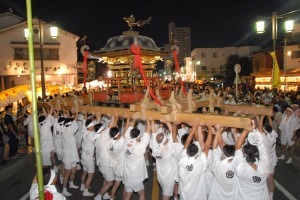Festivals

Nishio Gion Festival is a 400-year tradition, celebrated every year during the middle of July. A portable shrine is carried from Ibun Shrine, housing the guardian deity of Nishio castle town, to Mitsurugi Hachimangu located in Nishio Castle. It is said that if you pass under the portable shrine, you will be blessed with good health. A festival dance is performed, along with parades including the Daimyo (feudal lord) procession, giant floats, and dancing lions.

Bright giant lanterns light up the summer night sky. With over 400 years of history, this festival is celebrated every year on August 26th and 27th. There are six pairs of giant lanterns, totaling twelve lanterns, each of which is 6 to 10 meters long. It is said that the lanterns represent a bonfire lit in order to calm the sea monsters.

The museum displays a replica of giant lanterns used in the Mikawa Isshiki Lantern Festival. Visitors can learn about local festivals here.

Designated as a National Important Intangible Folk Cultural Property. This festival is held on January 7th according to the old calendar (the second Sunday of February in today’s calendar) and is said to have originated around 1,200 years ago. Two giant torches called “Suzumi,” each of which is 5 meters high and weighs 2 tons, are lit by two men (one each on the east and west sides) who are of an unlucky age. Then, brave participants wearing costumes made of old banners climb up on the burning Suzumi and compete to take sacred wood and twelve ropes out from the Suzumi. Finally, the men offer the sacred wood and twelve ropes to the gods, and the bounty of that year’s harvest is divined.

An annual festival held on January 3rd to pray for an abundant crop yield. The festival is said to have started in the Heian Period. Yaku-otoko (men of an unlucky age) wear a red costume and hang a daikon radish from their waist as a symbol of masculinity. They then march through the town and shaking their hips, accompanied by the sound of drums.










